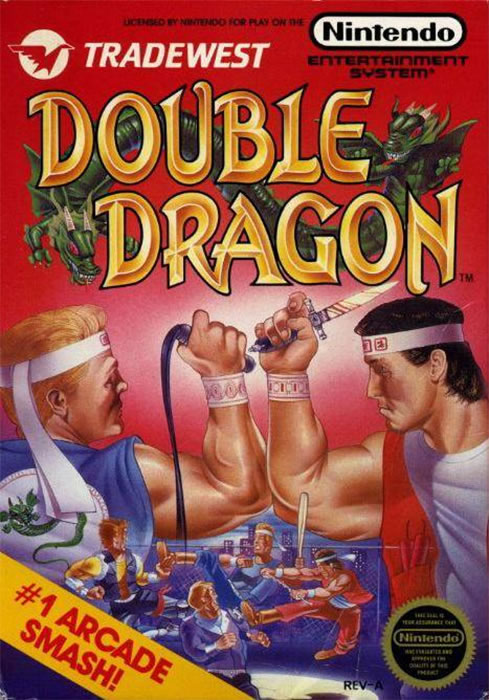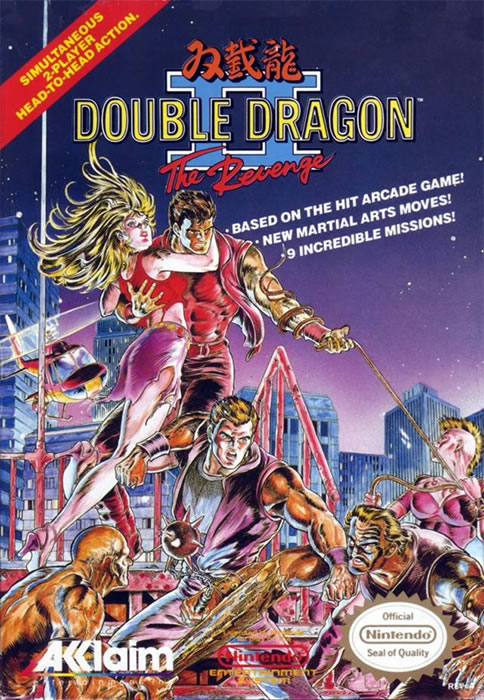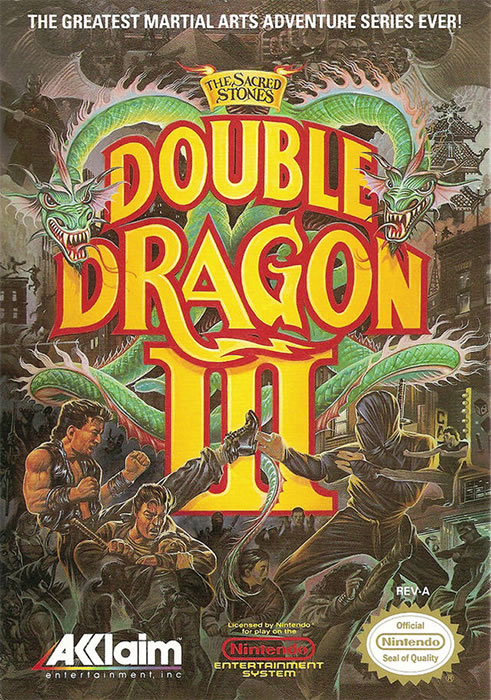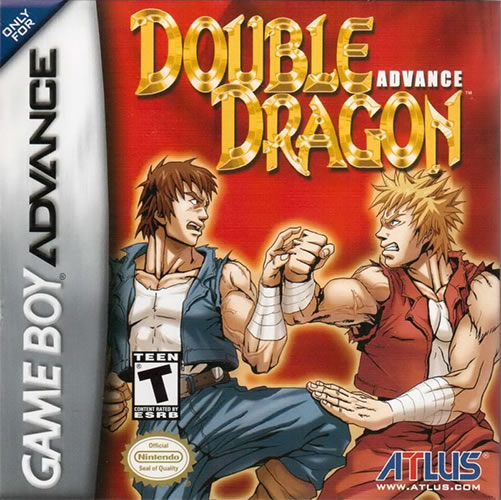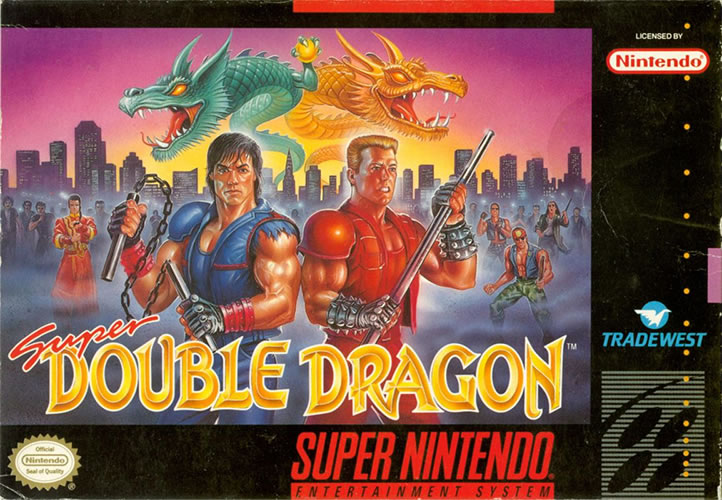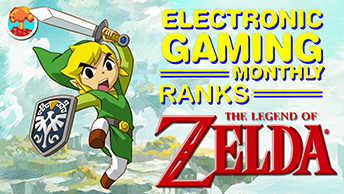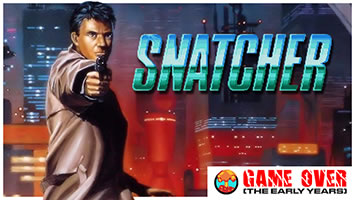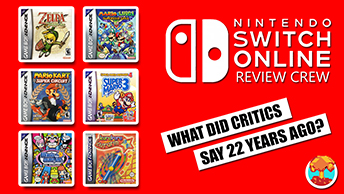- CLASSIC MAGAZINES
- REVIEW CREW
A show recapping what critics thought back
when classic games first came out! - NEXT GENERATION'S BEST & WORST
From the worst 1-star reviews to the best
5-stars can offer, this is Next Generation! - NINTENDO POWER (ARCHIVE)
Experience a variety of shows looking at the
often baffling history of Nintendo Power! - MAGAZINE RETROSPECTIVE
We're looking at the absolutely true history of
some of the most iconic game magazines ever! - SUPER PLAY'S TOP 600
The longest and most ambitious Super NES
countdown on the internet! - THEY SAID WHAT?
Debunking predictions and gossip found
in classic video game magazines! - NEXT GENERATION UNCOVERED
Cyril is back in this spin-off series, featuring the
cover critic review the art of Next Generation! - HARDCORE GAMER MAGAZING (PDF ISSUES)
Download all 36 issues of Hardcore Gamer
Magazine and relive the fun in PDF form!
- REVIEW CREW
- ELECTRONIC GAMING MONTHLY
- ELECTRONIC GAMING MONTHLY RANKS
From Mario to Sonic to Street Fighter, EGM
ranks classic game franchises and consoles! - ELECTRONIC GAMING MONTHLY BEST & WORST
Counting down EGM’s best and worst reviews
going year by year, from 1989 – 2009! - ELECTRONIC GAMING BEST & WORST AWARDS
11-part video series chronicling the ups and
downs of EGM’s Best & Worst Awards!
- ELECTRONIC GAMING MONTHLY RANKS
- GAME HISTORY
- GAME OVER: STORY BREAKDOWNS
Long-running series breaking down game
stories and analyzing their endings! - A BRIEF HISTORY OF GAMING w/ [NAME HERE]
Real history presented in a fun and pithy
format from a variety of game historians! - THE BLACK SHEEP
A series looking back at the black sheep
entries in popular game franchises! - INSTANT EXPERT
Everything you could possibly want to know
about a wide variety of gaming topics! - FREEZE FRAME
When something familiar happens in the games
industry, we're there to take a picture! - I'VE GOT YOUR NUMBER
Learn real video game history through a series
of number-themed episodes, starting at zero! - GREAT MOMENTS IN BAD ACTING
A joyous celebration of some of gaming's
absolute worst voice acting!
- GAME OVER: STORY BREAKDOWNS
- POPULAR SHOWS
- DG NEWS w/ LORNE RISELEY
Newsman Lorne Riseley hosts a regular
series looking at the hottest gaming news! - REVIEW REWIND
Cyril replays a game he reviewed 10+ years
ago to see if he got it right or wrong! - ON-RUNNING FEUDS
Defunct Games' longest-running show, with
editorials, observations and other fun oddities! - DEFUNCT GAMES QUIZ (ARCHIVE)
From online quizzes to game shows, we're
putting your video game knowledge to the test!- QUIZ: ONLINE PASS
Take a weekly quiz to see how well you know
the news and current gaming events! - QUIZ: KNOW THE GAME
One-on-one quiz show where contestants
find out if they actually know classic games! - QUIZ: THE LEADERBOARD
Can you guess the game based on the classic
review? Find out with The Leaderboard!
- QUIZ: ONLINE PASS
- DEFUNCT GAMES VS.
Cyril and the Defunct Games staff isn't afraid
to choose their favorite games and more! - CYRIL READS WORLDS OF POWER
Defunct Games recreates classic game
novelizations through the audio book format!
- DG NEWS w/ LORNE RISELEY
- COMEDY
- GAME EXPECTANCY
How long will your favorite hero live? We crunch
the numbers in this series about dying! - VIDEO GAME ADVICE
Famous game characters answer real personal
advice questions with a humorous slant! - FAKE GAMES: GUERILLA SCRAPBOOK
A long-running series about fake games and
the people who love them (covers included)! - WORST GAME EVER
A contest that attempts to create the worst
video game ever made, complete with covers! - LEVEL 1 STORIES
Literature based on the first stages of some
of your favorite classic video games! - THE COVER CRITIC
One of Defunct Games' earliest shows, Cover
Critic digs up some of the worst box art ever! - COMMERCIAL BREAK
Take a trip through some of the best and
worst video game advertisements of all time! - COMIC BOOK MODS
You've never seen comics like this before.
A curious mix of rewritten video game comics!
- GAME EXPECTANCY
- SERIES ARCHIVE
- NINTENDO SWITCH ONLINE ARCHIVE
A regularly-updated list of every Nintendo
Switch Online release, plus links to review! - PLAYSTATION PLUS CLASSIC ARCHIVE
A comprehensive list of every PlayStation
Plus classic release, including links! - RETRO-BIT PUBLISHING ARCHIVE
A regularly-updated list of every Retro-Bit
game released! - REVIEW MARATHONS w/ ADAM WALLACE
Join critic Adam Wallace as he takes us on a
classic review marathon with different themes!- DEFUNCT GAMES GOLF CLUB
Adam Wallace takes to the links to slice his way
through 72 classic golf game reviews! - 007 IN PIXELS
Adam Wallace takes on the world's greatest spy
as he reviews 15 weeks of James Bond games! - A SALUTE TO VAMPIRES
Adam Wallace is sinking his teeth into a series
covering Castlevania, BloodRayne and more! - CAPCOM'S CURSE
Adam Wallace is celebrating 13 days of Halloween
with a line-up of Capcom's scariest games! - THE FALL OF SUPERMAN
Adam Wallace is a man of steel for playing
some of the absolute worst Superman games! - THE 31 GAMES OF HALLOWEEN
Adam Wallace spends every day of October afraid
as he reviews some of the scariest games ever! - 12 WEEKS OF STAR TREK
Adam Wallace boldly goes where no critic has
gone before in this Star Trek marathon!
- DEFUNCT GAMES GOLF CLUB
- DAYS OF CHRISTMAS (ARCHIVE)
Annual holiday series with themed-episodes
that date all the way back to 2001!- 2015: 30 Ridiculous Retro Rumors
- 2014: 29 Magazines of Christmas
- 2013: 29 Questionable Power-Ups of Christmas
- 2012: 34 Theme Songs of Christmas
- 2011: 32 Game Endings of Christmas
- 2010: 31 Bonus Levels of Christmas
- 2009: 30 Genres of Christmas
- 2008: 29 Controls of Christmas
- 2007: 34 Cliches of Christmas
- 2006: 33 Consoles of Christmas
- 2005: 32 Articles of Christmas
- 2004: 31 Websites of Christmas
- 2003: 29 Issues of Christmas
- 2002: 28 Years of Christmas
- 2001: 33 Days of Christmas
- NINTENDO SWITCH ONLINE ARCHIVE
- REVIEW ARCHIVE
- FULL ARCHIVE
Billy & Jimmy Lee Return: 1980s Critics Review the Double Dragon Collection
Now that you're done with Super Mario Bros. Wonder, it's time to hit the streets with a completely different pair of siblings – Billy and Jimmy Lee. That's right, the Double Dragon Collection will be coming to PlayStation, Xbox and Switch on November 9th. This hotly-anticipated compilation will feature the Nintendo Entertainment System versions of Double Dragon, Double Dragon II: The Revenge and Double Dragon III: The Sacred Stones, as well as Super Double Dragon on Super NES, Double Dragon Advance on the Game Boy Advance and the awful Double Dragon IV from 2017. This sounds like an exciting collection, but I still need to ask: Are any of these games worth playing? To answer that question, I decided to flip through the pages of Electronic Gaming Monthly, Mean Machines, GamePro and more classic magazines to see what the critics said back when these games first came out. It's time to put those sibling rivalries aside, because this is going to be a fist-pumping episode of the Double Dragon Review Crew.
While it wasn't the first beat ‘em up to roundhouse kick the arcades, Double Dragon is definitely the one that everybody remembers. First released as a coin-op cabinet in 1987 and then on the Nintendo Entertainment System one year later, this was the world's introduction to Billy and Jimmy Lee, a pair of fist-fighting brothers who would not only go on to star in numerous sequels and spin-offs, but get their own Hollywood movie in 1994. This was a massive game at the time and all eyes were on the various home console ports, especially the one for the Nintendo Entertainment System. Let's see if the critics felt that the NES version lived up to the high-water mark left by the arcade original.
Double Dragon was one of Electronic Gaming Monthly's earliest reviews, coming at a time before they adopted their recognizable ten-point scale. They not only gave the brawler the highest score they had (a Direct Hit), but also named Double Dragon the Best Video Game of the Year for 1988. Joy Moon concluded that “it's a superb game, but it does have its shortcomings. A more appropriate name might have been Single Dragon, since the home version, unlike the arcade classic, only allows one player on the screen at a time. Don't by any means let this detour from what is otherwise an incredible gaming masterpiece. There are more screens than the arcade, as well as vertical scrolling and the one-on-one match that is very reminiscent of Karate Champ. My hat's off to Tradewest for the remarkable job they did on Double Dragon. This is a game that is worth every penny.”
Don't expect any Game of the Year awards from the British press, who were not as enthusiastic about Double Dragon as EGM. Computer & Video Games, for example, could only muster a score of 83% in their 86th issue. Raze liked it a bit more, but not enough to pair the right picture with their review. Giving it an 89% and using an image of Ghouls ‘N Ghosts, Raze argued that Double Dragon is “preferable to Bad Dudes, even though the UK cart conversion means you get a screen flicker every time the play area scrolls. Good fighting scenes are enhanced by some hilarious maneuvers, like grabbing your opponent by the hair and kneeing him in the face – nice subtle move. Great definition and animation of character and object make it worthy of Raze reader purchase.”
While Raze may have recommended it, Nintendo Magazine System seemed a little more hesitant, giving Double Dragon a score of 75%. The lowest score I could find came from Mean Machines, who gave it a 72%. “Graphically, this isn't outstanding – the sprites are small and the backgrounds aren't exactly tops. Sound isn't great either, being rather weedy and unmemorable. But even though the cosmetics are average, the game does supply some pretty enjoyable beat ‘em up action. However, when it comes to the bottom line, you'd be better off buying Double Dragon II, which is better looking and a lot more fun.”
Well, hang on there, Mr. Mean Machines. We'll get to the sequel in a minute. While far from perfect, this Nintendo Entertainment System port was still pretty good, giving us a cool two-player versus mode when they couldn't make the co-op gameplay work. That's quick thinking. It might not be my favorite game of 1988, but Double Dragon is still a great game that is worth playing.
The original Double Dragon is, without a doubt, one of the most influential arcade games of all time. That said, I would argue that the Nintendo Entertainment System sequel, Double Dragon II: The Revenge, is a substantially better game. It tells a cinematic story that is spread across a number of incredibly creative stages, all designed to push the Nintendo Entertainment System to the limits. And it works, because this is, at least in my opinion, the franchise's high-water mark. But let's see if the critics agree with my full-throated endorsement of Double Dragon II.
Based on the reviews over at Electronic Gaming Monthly, the critics definitely agreed with me. Ed called it “every bit as good, and even better, than the first. It's all new too! New moves, new scenes, great graphics, excellent player control and multiple difficulty levels. Double Dragon 2 is easily the best kick-and-punch game ever made.” Once again, Jim is here to back Ed up: “Double Dragon 2 represents a phenomenal improvement over the original Double Dragon. The graphics, gameplay and two-player interaction all combine to blow Double Dragon out of my NES.” EGM gave this sequel an average score of 8 out of 10.
On the other side of the coin you have Video Games & Computer Entertainment, which gave Double Dragon II the lowest score I could find, a 6 out of 10. “If at first you succeed ... do a sequel. This seems to have been the motto of moviemakers and, more recently, of gamemakers. Double Dragon II is the sequel to Double Dragon. It retains the strong points of the original, but improves on it in many ways. It is, to my way of thinking, a successful sequel.” That said, they ended up complaining about the challenging stages and the frustrating obstacles that lead to deaths that are outside of your control.
Across the pond, you saw Double Dragon II: The Revenge earn high scores from the British critics. For example, Nintendo Magazine System ended up going as high as an 84%. Mean Machines, on the other hand, went with an 80% and gave it a high recommendation. Julian argued that “although Double Dragon II looks a bit rough around the edges, it's great fun to play. The multitude of baddies to bash and the sheer variety of backdrops and weapons make this one stand head and shoulders above most Nintendo beat ‘em ups.” I absolutely agree. This is definitely one of the best 8-bit brawlers, and is leagues better than the Genesis and arcade sequels. Give it a play.
Once again, we have a home console sequel that veers wildly from the arcade original. While there are elements that tie this NES game back to The Rosetta Stone, Double Dragon III: The Sacred Stones is an altogether different beast. Marion has been kidnapped by a mysterious organization and the Lee brothers are forced to travel around the world hunting down a bunch of rocks. Of course, the story isn't important, because the only thing anybody remembers about this game is that it occasionally calls Billy Lee “Bimmy” in a couple of cut scenes. Yeah, that's embarrassing, but I would argue that The Sacred Stones has a lot more going for it. Let's see if the critics agree with me.
While it may not have been in consideration for Game of the Year, Electronic Gaming Monthly liked Double Dragon III as much as the second installment. Giving it a score of 9 out of 10, Sushi-X concluded that, “as a true fan of the Double Dragon series, I was blown away by the excellent sequel of sequels. The new moves, cast and storyline add a whole new dimension to intense fighting action.” Martin wasn't as impressed, giving the game a 7: “Double Dragon 3 is another good fighting game that resembles part 2 in most aspects. Lots of technique to master before you beat this one. I like the other characters that you change into. Cool graphics and awesome moves kept my interest.” EGM ultimately gave this Double Dragon sequel an average score of 8 out of 10.
Other critics were not as impressed with The Sacred Stones. Nintendo Power gave the beat ‘em up a low score of 3.3 out of 5 in their 23rd issue. Mean Machines wasn't that much better, giving the sequel a pitiful score of 65%. “Arrrgghhh! I've played this game a lot over the last few months and it's taken me ages just to get off the first level. I just can't understand why the game's designers chose to make Double Dragon III so difficult. A good challenge increases a game's longevity, but this is just so tough you're instantly put off. It's a shame, really, because this game has the best graphics of the Nintendo Double Dragon series. It also beats its predecessors in terms of depth as well. If you're a die hard Double Dragon nut who completed the first two chapters of the series with incredible ease, I recommend this without hesitation. However, it's just too difficult and frustrating for the average games player.”
Now, if you're looking for the highest score, then look no further than GamePro. Giving the game a perfect 5 out of 5, they concluded that “Double Dragon III is one of the toughest street fighting carts around. The graphics won't knock you out, but the fighting definitely will. If you've mastered the first two Double Dragon carts, then you must tackle this one, too, but be forewarned: The knuckle-busting gets pretty dirty. It's the law of the video jungle: Beat or be beaten.”
While I prefer Double Dragon II over this third installment, The Sacred Stones is still worth a play. That said, Mean Machines was right, it is tough, so if you get frustrated easily, Double Dragon III might not be for you.
The early part of the 21st century was not particularly kind to the traditional 2D side-scrolling beat ‘em up. This was a genre that was desperately trying to evolve, with companies like Square doing everything in their power to push the old school brawler into a 3D world with games like The Bouncer. This would eventually lead to The Warriors from Rockstar, God Hand from Capcom and Sega's long-running Yakuza series. While many of those games are a lot of fun, fans of the beat ‘em ups made famous in the 1980s and 90s were left with little more than re-releases of the arcade classics on Game Boy Advance, such as Final Fight One in 2001 and the game we're going to talk about now – Double Dragon Advance.
While I call it a port, the truth is that this 2003 brawler has a lot going for it. The visuals have been beefed up a bit, the different characters have more moves and there are even four new stages to fight through. That was a big deal to fans of old school beat ‘em ups, who were not exactly being catered to in 2003. But the real question remains: Was this enough to win back critics who had given up on the genre a decade ago?
Unfortunately, the answer is no. Few magazines covered Double Dragon Advance, the ones that did weren't especially kind. GamePro gave it a 3.5 out of 5, concluding that “Graphically, the character animation is much improved. Cut scenes resembling comic book panels have been inserted between levels and offer more detailed portrayals of vanquished enemies (complete with silly dialogue). The authentic 8-bit musical score is a retro treat and may induce nostalgia and giddiness. The fun factor suffers only because of minor problems with the controls and collision detection. Nothing hurts more than falling off a ledge you were sure you were standing on or being hit by someone you thought was out of range.”
This is in line with where GMR was back in 2003. They gave it a 6 out of 10, echoing a lot of what GamePro said. “Double Dragon betters the looks of the beat ‘em up franchise that began in 1985, plus adds a few gameplay twists. Purple-tights-clad femme fatales and big bald guys named Abobo remain. But Atlus added new moves, new enemies, and new gameplay modes such as survival and single-player tag team. Though nostalgia hounds will likely be amused, others will probably want more depth from the best beat ‘em up 1985 had to offer.”
Look, I'm not trying to be a stickler here, but Double Dragon came out in 1987, not 1985. And while I certainly understand why critics weren't excited for an enhanced port of Double Dragon in 2003, I would argue this version is probably better than the scores suggest.
Although there was only a two-year gap between the release of the last 8-bit Double Dragon game, The Sacred Stones, and Super Double Dragon on the Super NES, a lot had changed in that two years. We not only saw the home console release of the arcade smash hit Final Fight, but Sega stole Capcom's thunder with the critical-darling Streets of Rage. You would think that the franchise that was largely responsible for popularizing the genre would have no problem picking up where it left off, but Super Double Dragon failed to make the same impact on 16-bit consoles. This was a game that initially found itself overshadowed by the Streets of Rage/Final Fight feud, only to be overshadowed once again by a wave of one-on-one fighting games. Super Double Dragon couldn't catch a break.
Believe it or not, this Super NES brawler was one of the most polarizing games of 1992. Based on the magazine reviews, you either thought it was perfect or kind of underwhelming. Let's go ahead and start with the top-scores, which included GamePro giving Super Double Dragon a score of 5 out of 5: They were especially impressed with the tight gameplay and diverse levels, arguing that “Super Double Dragon is one tough customer. If you like to talk beat ‘em up stuff, you've got nothing to say until you beat this cart! Super Double Dragon kicks.”
Similarly, Die Hard Game Fan was prepared to give the game near perfect scores. Brody compared it to the other games on the market: “This is an incredible fighting game that lives up to Streets of Rage fame. The amount of details and moves in this game are seriously outstanding. Throw in a two-player option plus 16-bit versions of Double Dragon tunes and you've got an awesome game.” Skip went even higher, noting that “if you like fighting games, then this is your game. Double Dragon is definitely the best fighting game for the Super NES.”
On the flip side of that coin, you saw a lot of critics who were disappointed in Super Double Dragon. N-Force, for example, gave the game a so-so 70%, while Nintendo Power went even lower with a 3.2 out of 5. Nestled right in the middle is Super Play, who had a lot of complaints about the presentation: “The thing that will put most people off are the 8-bit graphics. While Super Double Dragon has a couple of attractive section, there's no denying it's a pretty poor attempt, with more of a play-it-safe style than anything else. There is some hidden charm here, but I find it hard to justify spending this much money on such a primitive game – it's fun and quite tough for a while, but don't you think the Super NES deserves better?” Super Play ultimately gave Super Double Dragon a score of 68%, calling it a “waste of money.”
While there are other 16-bit brawlers I would rather play, Super Double Dragon deserves a reevaluation. These critics were either too harsh or not critical enough, with the right answer being somewhere in the middle. It definitely was not the best fighting game of 1992, but it was also nowhere near being a waste of money. Funny how that works.
| Publication | Scores |
|---|---|
| Electronic Gaming Monthly | Direct Hit |
| Nintendo Magazine System | 89% |
| Computer & Video Games | 83% |
| Raze | 75% |
| Mean Machines | 72% |
| AVERAGE SCORE | 84% |
Double Dragon was one of Electronic Gaming Monthly's earliest reviews, coming at a time before they adopted their recognizable ten-point scale. They not only gave the brawler the highest score they had (a Direct Hit), but also named Double Dragon the Best Video Game of the Year for 1988. Joy Moon concluded that “it's a superb game, but it does have its shortcomings. A more appropriate name might have been Single Dragon, since the home version, unlike the arcade classic, only allows one player on the screen at a time. Don't by any means let this detour from what is otherwise an incredible gaming masterpiece. There are more screens than the arcade, as well as vertical scrolling and the one-on-one match that is very reminiscent of Karate Champ. My hat's off to Tradewest for the remarkable job they did on Double Dragon. This is a game that is worth every penny.”
Don't expect any Game of the Year awards from the British press, who were not as enthusiastic about Double Dragon as EGM. Computer & Video Games, for example, could only muster a score of 83% in their 86th issue. Raze liked it a bit more, but not enough to pair the right picture with their review. Giving it an 89% and using an image of Ghouls ‘N Ghosts, Raze argued that Double Dragon is “preferable to Bad Dudes, even though the UK cart conversion means you get a screen flicker every time the play area scrolls. Good fighting scenes are enhanced by some hilarious maneuvers, like grabbing your opponent by the hair and kneeing him in the face – nice subtle move. Great definition and animation of character and object make it worthy of Raze reader purchase.”
While Raze may have recommended it, Nintendo Magazine System seemed a little more hesitant, giving Double Dragon a score of 75%. The lowest score I could find came from Mean Machines, who gave it a 72%. “Graphically, this isn't outstanding – the sprites are small and the backgrounds aren't exactly tops. Sound isn't great either, being rather weedy and unmemorable. But even though the cosmetics are average, the game does supply some pretty enjoyable beat ‘em up action. However, when it comes to the bottom line, you'd be better off buying Double Dragon II, which is better looking and a lot more fun.”
Well, hang on there, Mr. Mean Machines. We'll get to the sequel in a minute. While far from perfect, this Nintendo Entertainment System port was still pretty good, giving us a cool two-player versus mode when they couldn't make the co-op gameplay work. That's quick thinking. It might not be my favorite game of 1988, but Double Dragon is still a great game that is worth playing.
| Publication | Scores |
|---|---|
| Nintendo Magazine System | 84% |
| Mean Machines | 83% |
| Electronic Gaming Monthly | 8/10 |
| Video Games & Computer Entertainment | 6/10 |
| AVERAGE SCORE | 77% |
Based on the reviews over at Electronic Gaming Monthly, the critics definitely agreed with me. Ed called it “every bit as good, and even better, than the first. It's all new too! New moves, new scenes, great graphics, excellent player control and multiple difficulty levels. Double Dragon 2 is easily the best kick-and-punch game ever made.” Once again, Jim is here to back Ed up: “Double Dragon 2 represents a phenomenal improvement over the original Double Dragon. The graphics, gameplay and two-player interaction all combine to blow Double Dragon out of my NES.” EGM gave this sequel an average score of 8 out of 10.
On the other side of the coin you have Video Games & Computer Entertainment, which gave Double Dragon II the lowest score I could find, a 6 out of 10. “If at first you succeed ... do a sequel. This seems to have been the motto of moviemakers and, more recently, of gamemakers. Double Dragon II is the sequel to Double Dragon. It retains the strong points of the original, but improves on it in many ways. It is, to my way of thinking, a successful sequel.” That said, they ended up complaining about the challenging stages and the frustrating obstacles that lead to deaths that are outside of your control.
Across the pond, you saw Double Dragon II: The Revenge earn high scores from the British critics. For example, Nintendo Magazine System ended up going as high as an 84%. Mean Machines, on the other hand, went with an 80% and gave it a high recommendation. Julian argued that “although Double Dragon II looks a bit rough around the edges, it's great fun to play. The multitude of baddies to bash and the sheer variety of backdrops and weapons make this one stand head and shoulders above most Nintendo beat ‘em ups.” I absolutely agree. This is definitely one of the best 8-bit brawlers, and is leagues better than the Genesis and arcade sequels. Give it a play.
| Publication | Scores |
|---|---|
| GamePro | 5/5 |
| Electronic Gaming Monthly | 8/10 |
| Nintendo Power | 3.3/5 |
| Mean Machines | 65% |
| AVERAGE SCORE | 78% |
While it may not have been in consideration for Game of the Year, Electronic Gaming Monthly liked Double Dragon III as much as the second installment. Giving it a score of 9 out of 10, Sushi-X concluded that, “as a true fan of the Double Dragon series, I was blown away by the excellent sequel of sequels. The new moves, cast and storyline add a whole new dimension to intense fighting action.” Martin wasn't as impressed, giving the game a 7: “Double Dragon 3 is another good fighting game that resembles part 2 in most aspects. Lots of technique to master before you beat this one. I like the other characters that you change into. Cool graphics and awesome moves kept my interest.” EGM ultimately gave this Double Dragon sequel an average score of 8 out of 10.
Other critics were not as impressed with The Sacred Stones. Nintendo Power gave the beat ‘em up a low score of 3.3 out of 5 in their 23rd issue. Mean Machines wasn't that much better, giving the sequel a pitiful score of 65%. “Arrrgghhh! I've played this game a lot over the last few months and it's taken me ages just to get off the first level. I just can't understand why the game's designers chose to make Double Dragon III so difficult. A good challenge increases a game's longevity, but this is just so tough you're instantly put off. It's a shame, really, because this game has the best graphics of the Nintendo Double Dragon series. It also beats its predecessors in terms of depth as well. If you're a die hard Double Dragon nut who completed the first two chapters of the series with incredible ease, I recommend this without hesitation. However, it's just too difficult and frustrating for the average games player.”
Now, if you're looking for the highest score, then look no further than GamePro. Giving the game a perfect 5 out of 5, they concluded that “Double Dragon III is one of the toughest street fighting carts around. The graphics won't knock you out, but the fighting definitely will. If you've mastered the first two Double Dragon carts, then you must tackle this one, too, but be forewarned: The knuckle-busting gets pretty dirty. It's the law of the video jungle: Beat or be beaten.”
While I prefer Double Dragon II over this third installment, The Sacred Stones is still worth a play. That said, Mean Machines was right, it is tough, so if you get frustrated easily, Double Dragon III might not be for you.
| Publication | Scores |
|---|---|
| Game Informer | 9/10 |
| GamePro | 3.5/5 |
| GMR | 6/10 |
| AVERAGE SCORE | 73% |
While I call it a port, the truth is that this 2003 brawler has a lot going for it. The visuals have been beefed up a bit, the different characters have more moves and there are even four new stages to fight through. That was a big deal to fans of old school beat ‘em ups, who were not exactly being catered to in 2003. But the real question remains: Was this enough to win back critics who had given up on the genre a decade ago?
Unfortunately, the answer is no. Few magazines covered Double Dragon Advance, the ones that did weren't especially kind. GamePro gave it a 3.5 out of 5, concluding that “Graphically, the character animation is much improved. Cut scenes resembling comic book panels have been inserted between levels and offer more detailed portrayals of vanquished enemies (complete with silly dialogue). The authentic 8-bit musical score is a retro treat and may induce nostalgia and giddiness. The fun factor suffers only because of minor problems with the controls and collision detection. Nothing hurts more than falling off a ledge you were sure you were standing on or being hit by someone you thought was out of range.”
This is in line with where GMR was back in 2003. They gave it a 6 out of 10, echoing a lot of what GamePro said. “Double Dragon betters the looks of the beat ‘em up franchise that began in 1985, plus adds a few gameplay twists. Purple-tights-clad femme fatales and big bald guys named Abobo remain. But Atlus added new moves, new enemies, and new gameplay modes such as survival and single-player tag team. Though nostalgia hounds will likely be amused, others will probably want more depth from the best beat ‘em up 1985 had to offer.”
Look, I'm not trying to be a stickler here, but Double Dragon came out in 1987, not 1985. And while I certainly understand why critics weren't excited for an enhanced port of Double Dragon in 2003, I would argue this version is probably better than the scores suggest.
| Publication | Scores |
|---|---|
| GamePro | 5/5 |
| Die Hard Game Fan | 97% |
| N-Force | 70% |
| Super Play | 68% |
| Nintendo Power | 3.2/5 |
| AVERAGE SCORE | 80% |
Believe it or not, this Super NES brawler was one of the most polarizing games of 1992. Based on the magazine reviews, you either thought it was perfect or kind of underwhelming. Let's go ahead and start with the top-scores, which included GamePro giving Super Double Dragon a score of 5 out of 5: They were especially impressed with the tight gameplay and diverse levels, arguing that “Super Double Dragon is one tough customer. If you like to talk beat ‘em up stuff, you've got nothing to say until you beat this cart! Super Double Dragon kicks.”
Similarly, Die Hard Game Fan was prepared to give the game near perfect scores. Brody compared it to the other games on the market: “This is an incredible fighting game that lives up to Streets of Rage fame. The amount of details and moves in this game are seriously outstanding. Throw in a two-player option plus 16-bit versions of Double Dragon tunes and you've got an awesome game.” Skip went even higher, noting that “if you like fighting games, then this is your game. Double Dragon is definitely the best fighting game for the Super NES.”
On the flip side of that coin, you saw a lot of critics who were disappointed in Super Double Dragon. N-Force, for example, gave the game a so-so 70%, while Nintendo Power went even lower with a 3.2 out of 5. Nestled right in the middle is Super Play, who had a lot of complaints about the presentation: “The thing that will put most people off are the 8-bit graphics. While Super Double Dragon has a couple of attractive section, there's no denying it's a pretty poor attempt, with more of a play-it-safe style than anything else. There is some hidden charm here, but I find it hard to justify spending this much money on such a primitive game – it's fun and quite tough for a while, but don't you think the Super NES deserves better?” Super Play ultimately gave Super Double Dragon a score of 68%, calling it a “waste of money.”
While there are other 16-bit brawlers I would rather play, Super Double Dragon deserves a reevaluation. These critics were either too harsh or not critical enough, with the right answer being somewhere in the middle. It definitely was not the best fighting game of 1992, but it was also nowhere near being a waste of money. Funny how that works.
HOME |
CONTACT |
NOW HIRING |
WHAT IS DEFUNCT GAMES? |
NINTENDO SWITCH ONLINE |
RETRO-BIT PUBLISHING
Retro-Bit |
Switch Planet |
The Halcyon Show |
Same Name, Different Game |
Dragnix |
Press the Buttons
Game Zone Online | Hardcore Gamer | The Dreamcast Junkyard | Video Game Blogger
Dr Strife | Games For Lunch | Mondo Cool Cast | Boxed Pixels | Sega CD Universe | Gaming Trend
Game Zone Online | Hardcore Gamer | The Dreamcast Junkyard | Video Game Blogger
Dr Strife | Games For Lunch | Mondo Cool Cast | Boxed Pixels | Sega CD Universe | Gaming Trend
Copyright © 2001-2025 Defunct Games
All rights reserved. All trademarks are properties of their respective owners.
All rights reserved. All trademarks are properties of their respective owners.







